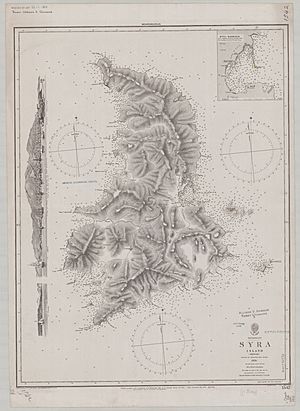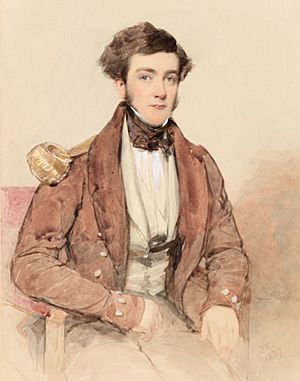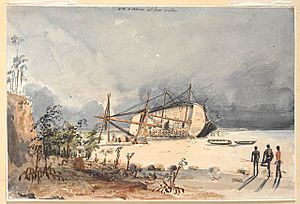Owen Stanley facts for kids
Owen Stanley (born June 13, 1811 – died March 13, 1850) was a British naval officer and explorer. He was part of the Royal Navy, which is the United Kingdom's navy. Owen Stanley was also a skilled surveyor, meaning he helped map out new areas of the world. He explored many places, especially around Australia and New Guinea.
Contents
Owen Stanley was born in a place called Alderley, Cheshire, England. His father, Edward Stanley, was a church leader who later became a bishop. Owen had a brother named Arthur Penrhyn Stanley and a sister named Mary Stanley.
Owen joined the Royal Naval College when he was about 15 years old. After training, he became a midshipman in 1826. He sailed to South America on HMS Ganges and HMS Forte. In 1830, he joined Phillip Parker King on HMS Adventure. They surveyed the Straits of Magellan at the tip of South America.
Peacekeeping in the Mediterranean
After the Greek War of Independence ended in 1829, Owen Stanley helped with peacekeeping efforts. He served in the Mediterranean Sea from 1831 to 1836. He was a mate on HMS Belvidera and then worked with Captain John Franklin on HMS Rainbow.

In 1831, he became a lieutenant. He served on several ships in Greece, including HMS Kent, HMS Procris, and HMS Malabar. His last ship in the Mediterranean was HMS Mastiff. During this time, he spent 84 days mapping the Gulf of Corinth in a small boat.
Arctic Exploration and Command
In 1836, Owen Stanley sailed to the Arctic as a scientist. He was on HMS Terror under George Back. This was a very cold and challenging journey.
In 1838, he was given command of HMS Britomart. He sailed to Australia and New Zealand. During this voyage, he was promoted to commander in 1839. In 1842, he was also chosen as a Fellow of the Royal Society. This is a special honor for scientists.
After returning in 1843, he worked on shore for a few years. In 1844, he was promoted again to captain when he was 33 years old.
Voyage of the Rattlesnake and Final Years
In December 1846, Captain Stanley took charge of HMS Rattlesnake. Famous naturalists like Thomas Huxley and John MacGillivray were on board. An artist named Oswald Walters Brierly also joined the trip. They were joined by HMS Bramble, led by Charles Bampfield Yule.
In 1847, they arrived at Port Curtis in Australia. Stanley surveyed the harbor and said it was a very good place to anchor ships. In 1848, he continued north to map New Guinea. He also helped Edmund Kennedy's expedition to the Cape York Peninsula.
Owen Stanley then surveyed the Louisiade Archipelago. However, he became ill in 1849. He died in March 1850 after returning to Sydney, Australia.
John MacGillivray wrote a two-book story about the Rattlesnake's journey. Thomas Huxley also wrote a diary about the voyage, which was published later.
Owen Stanley is buried in St Thomas Rest Park in Cammeray, Sydney.
Legacy
The Owen Stanley Range in New Guinea is a mountain range named after him.
His brother, Dean Stanley, gave a special baptism font to ChristChurch Cathedral in New Zealand. He did this to remember Owen.
See also
- European and American voyages of scientific exploration
Images for kids




